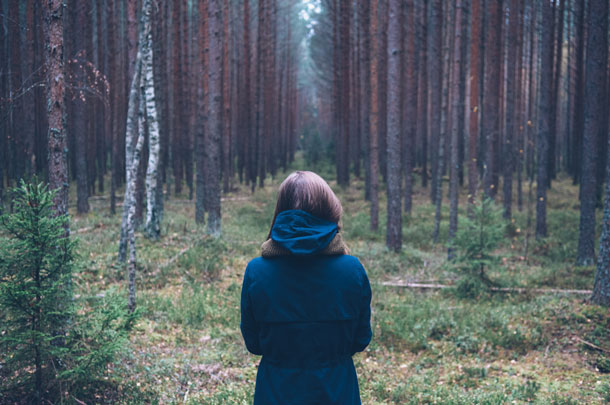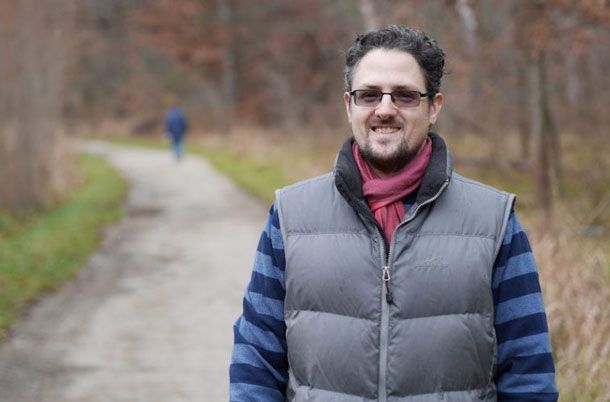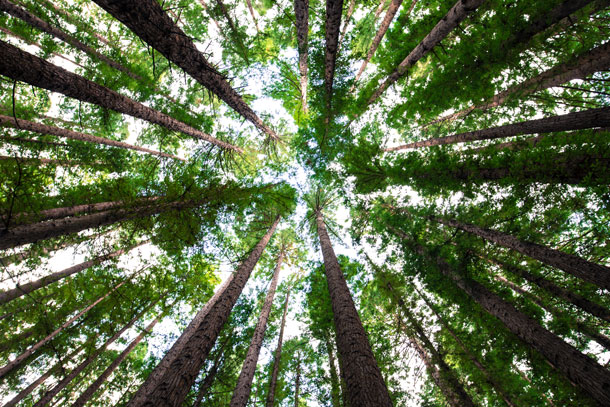'Forest Bathing' for Health
Air Date: Week of January 11, 2019

Studies show that 'forest bathing', or shinrin-yoku as it is known in Japan, appears to have health benefits. (Photo: Jordan Sanchez on Unsplash)
A walk in the woods might be just what your health provider ordered. Numerous studies suggest that taking in the peaceful atmosphere of a forest can have significant health benefits. Now the practice of “forest bathing,” which originated in Japan in the 1980s as a form of nature therapy, is becoming more popular around the world. From a forested Pittsburgh park, Kara Holsopple reports on this practice for the Allegheny Front.
Transcript
CURWOOD: Call it biophilia, love of the outdoors or simply common sense, research shows that spending time in nature can improve human health. In fact, the Japanese have a tradition known as shinrin-yoku or forest bathing, in which practitioners spend meditative time breathing in nature. Allegheny Front reporter, Kara Holsopple, went to Frick Park in Pittsburg to meet up with Moshe Sherman, a medical Qi Gong therapist who leads regular forest bathing outings.
SHERMAN: The first bathing started in Japan in the 80s as a form of preventative health care. And the idea is that in order to balance the stress of urban life, we need to expose ourselves to nature. And it's very simple. In fact, to just get yourself into nature and be present.
HOLSOPPLE: How is it different than taking a walk or hiking?
SHERMAN: Well, we don't have a destination in mind. And we don't rush just like when we take a bath in hot water, we settle in and relax, we can talk but it's not a time to talk about work like we might do during a walk with a friend or to complain about relationships. It's more time to go inward.
HOLSOPPLE: You're looking up.
SHERMAN: Yes, when we first bathe, we want to look all around and just take it in. So we breathe in the healing energy. We also bring it in through our eyes, we bring it in through our ears, hearing the sounds we bring in through feeling whether it's feeling the weather or touching a leaf. In Japan the term for forest bathing is shinrin-yoku and that literally means to bring in the forest.
HOLSOPPLE: Bring it in to yourself.
SHERMAN: Exactly, in the urban environment we often have to put up what I call energetic shields to protect us. I love cities. I've grown up in the city live in a city my whole life, but I can feel when I come into the forest. It's a chance for those shields to come down.
HOLSOPPLE: Even the muds kind of a soothing sound.

Moshe Sherman is a medical QiGong therapist who leads forest bathing sessions in Pennsylvania parks. (Photo: Kara Holsopple)
SHERMAN: Yes, it is. I was just listening to that as well. Each session is different. There was one session where we did a really fun exercise. We all put our hands on the same tree. And we did a guided meditation where we pretended we were squirrels running up the tree and we got to the top of the tree, looked around and ran back down. And at first I was wondering if anyone was there with me, if it's just me. I got some good feedback afterwards it was a lot of fun.
One of the nice things about forest bathing is it has been widely researched mostly in Asia and also in Europe. And what brought the most recent attention to the United States is a review that was published in summer of 2017 that looked at 64 of those research studies which are all based on empirical evidence, and it really impacts so many systems of the body, cardiovascular system, the respiratory system, and most profoundly, I think, to me right now is how it impacts the immune system. If you do one session of forest bathing for even 20 minutes, we see an increase in what's called the NK cells are the natural killer cells. And these are the cells that protect us from viruses and even from tumor formations.
HOLSOPPLE: Is it just the healing power of nature or something else going on? You know, like, what about being in nature is so good for us?
SHERMAN: There's many levels to it, I don't claim to understand them all. Trees emit something called phytoncides. And these are organic compounds that are released by trees to protect the trees themselves from parasites, disease, and they're actually beneficial for human health as well. So when we're around trees, and we're around plant life, we're breathing those in. I work with Chi or energy, which is a little more abstract, but I think of each tree and each plant as being a unique life form with its own consciousness. And I think when we expose ourselves to a variety of different life forms, it benefits us and I like to think of benefits trees as well, so I think it's a friendship.

Forest bathing advocates say even just a few minutes in a forest can help change your energy and mood. (Photo: Arnaud Mesureur on Unsplash)
HOLSOPPLE: What do people report to you? What do they say afterwards about the experience?
SHERMAN: Lots of times....
HOLSOPPLE: Does anybody hate it?
SHERMAN: No, I've never had anyone hate, or being unsatisfied, people usually feel more relaxed, more present. And really, when you start to talk to people, you realize that they're processing some heavy stuff that they're going through in their lives, and it helps them with that. People report feeling overall, better is the general feeling you get. I feel great people are chatty, which is always a good sign after a healing session or after a group event, when people feel chatty, it means the energies flowing it means they're feeling uplifted and feeling open to sharing and receiving.
HOLSOPPLE: I'm glad I didn't cancel.
SHERMAN: Me too. Yeah, this is great. You can feel the benefits almost immediately. And then notice how they last they last with you. Lots of times I'll feel them wearing off and that's when I'll get myself back to the park back to the forest. Once you learn how to forest bathe you can do it anytime you don't need a guide although it's more fun when you come do it with a group, but you can do it yourself once you know how to do it. So it's it's like that saying, you know, give a person a fish they eat for a day, teach them how to fish they can eat forever. I think forest bathing is so essential to modern life and creating a balance and health in the modern environment.
CURWOOD: Kara Holsopple’s report comes to us courtesy of The Allegheny Front. And by the way, Moshe Sherman says if you are in a crunch for time, simply sitting under a tree for a while can change your energy and mood.
Links
This story on the Allegheny Front website
The New York Times | “Take A Walk in the Woods. Doctor’s Orders.”
A meta-analysis of the potential health benefits of spending time outdoors
Living on Earth wants to hear from you!
Living on Earth
62 Calef Highway, Suite 212
Lee, NH 03861
Telephone: 617-287-4121
E-mail: comments@loe.org
Newsletter [Click here]
Donate to Living on Earth!
Living on Earth is an independent media program and relies entirely on contributions from listeners and institutions supporting public service. Please donate now to preserve an independent environmental voice.
NewsletterLiving on Earth offers a weekly delivery of the show's rundown to your mailbox. Sign up for our newsletter today!
 Sailors For The Sea: Be the change you want to sea.
Sailors For The Sea: Be the change you want to sea.
 The Grantham Foundation for the Protection of the Environment: Committed to protecting and improving the health of the global environment.
The Grantham Foundation for the Protection of the Environment: Committed to protecting and improving the health of the global environment.
 Contribute to Living on Earth and receive, as our gift to you, an archival print of one of Mark Seth Lender's extraordinary wildlife photographs. Follow the link to see Mark's current collection of photographs.
Contribute to Living on Earth and receive, as our gift to you, an archival print of one of Mark Seth Lender's extraordinary wildlife photographs. Follow the link to see Mark's current collection of photographs.
 Buy a signed copy of Mark Seth Lender's book Smeagull the Seagull & support Living on Earth
Buy a signed copy of Mark Seth Lender's book Smeagull the Seagull & support Living on Earth

